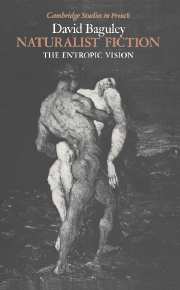Book contents
- Frontmatter
- Contents
- Acknowledgments
- Introduction
- 1 Histories
- 2 Theories: realism, naturalism, genre
- 3 The founding texts
- 4 The tragic model
- 5 Comic strains
- 6 In the ironic modes: naturalist satire and parody
- 7 The ‘scandal’ of naturalism
- 8 Naturalist description
- 9 The entropic vision
- 10 By way of conclusion: two English examples
- Notes
- Translations of passages in French
- Select bibliography
- Index
- Cambridge Studies in French
8 - Naturalist description
Published online by Cambridge University Press: 14 October 2009
- Frontmatter
- Contents
- Acknowledgments
- Introduction
- 1 Histories
- 2 Theories: realism, naturalism, genre
- 3 The founding texts
- 4 The tragic model
- 5 Comic strains
- 6 In the ironic modes: naturalist satire and parody
- 7 The ‘scandal’ of naturalism
- 8 Naturalist description
- 9 The entropic vision
- 10 By way of conclusion: two English examples
- Notes
- Translations of passages in French
- Select bibliography
- Index
- Cambridge Studies in French
Summary
We must leave Parigot's parodic novelist, at least for the time being, pondering upon the crucial question of the nature of nature in the naturalist scheme, and observe that, in certain theoretical statements, ‘nature’, ‘naturalism’ and ‘description’ became almost interchangeable terms. In the opening section of his article ‘De la description’, reproduced in Le Roman expérimental, Zola writes: ‘sous cette question littéraire de la description, il n'y a pas autre chose que le retour à la nature, ce grand courant naturaliste qui a produit nos croyances et nos connaissances actuelles’ (X, 1299). The naturalist, in the image of Zola, is popularly represented as a zealous observer, assiduously frequenting the sites of his future novel, notebook in hand, filling it with notations that will provide passages of authentic description in the work under preparation. The naturalist mode is regularly considered to be one which gives primacy to description, not lavish, emotionally charged Romantic raptures nor Parnassian gems, but concrete, material delineations, inspired by the belief that an accumulation of ‘petits faits vrais’ would give a sufficient representation of the truth. According to Northrop Frye, ‘in the documentary naturalism generally associated with such names as Zola and Dreiser, literature goes about as far as a representation of life, to be judged by its accuracy of description rather than by its integrity as a structure of words, as it could go and still remain literature’. Indeed, beneath Zola's portrait, Parigot's novelist, Pierre, solemnly declares: ‘la description est la formule de l'Art, le dernier mot de notre Ecole’.
Zola's essay provides, in a convenient form, the main arguments of the orthodox naturalist doctrine on the question of description.
- Type
- Chapter
- Information
- Naturalist FictionThe Entropic Vision, pp. 184 - 203Publisher: Cambridge University PressPrint publication year: 1990



